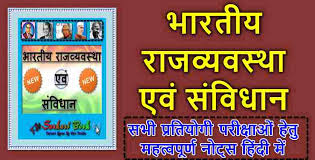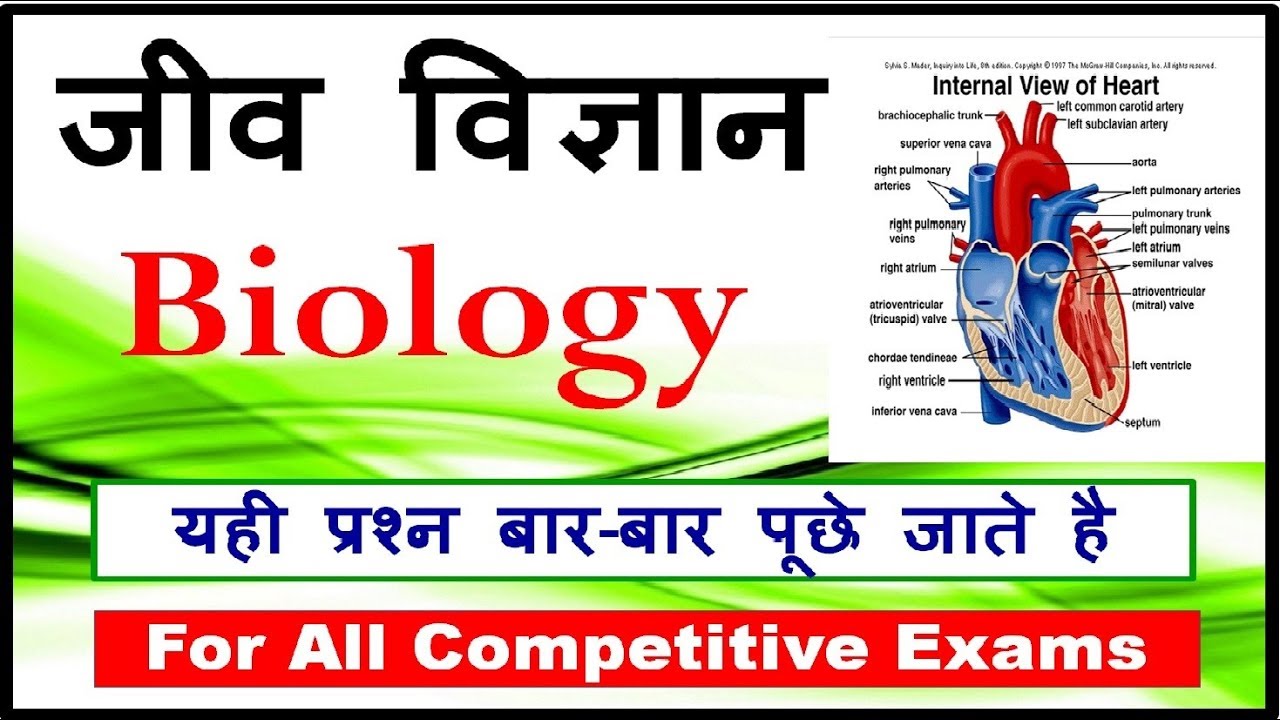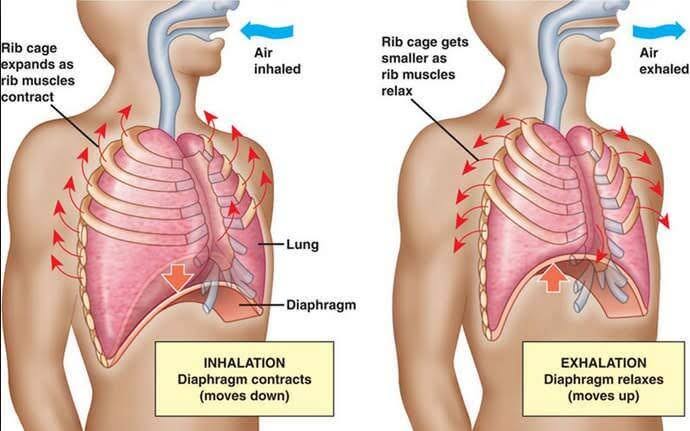
Notes on Breathing and Exchange of Gases – Government Job Exam Preparation Notes NEET JEE IIT
♦️Notes on Breathing and Exchange of Gases
Pulmonary Volumes and Capacities
There are following respiratory volumes and capacity:
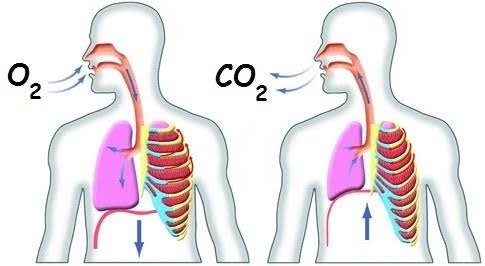
(i) Tidal volume (TV)
It is volume of air normally inspired or expired in one breath (i.e. inspiration and expiration) without any extra effort. It is about 500 ml in normal healthy adult. In infants it is 15 ml and in fetus it is 0 ml.
(ii) Inspiratory reserve volume (IRV) :
By taking a very deep breath, you can inspire a good deal more than 500 ml. This additional inhaled air, called IRV is about 3000 ml.
(iii) Expiratory reserve volume (ERV) :
If you inhale normally & then exhale as forcibly as possible, you should be able to push out 1200 ml of air in addition to 500ml. of T.V. The extra 1200 ml is called ERV.
(iv) Residual volume (RV):
Even after expiratory reserve volume is expelled, considerable air remains in the lung, this volume, which cannot be measured by spirometry, and it is called residual volume is about 1200 ml.
(v) Dead space:
Portion of tracheobronchial tree where gaseous exchange does not occur is called dead space. It is also called conductive zone. Dead space is 150 ml.
(vi) Functional residual capacity (FRC):
It is the amount of air that remains in the lungs after a normal expiration. It is about 2300 ml.
FRC = ERV + RV = 1100 + 1200 = 2300 ml.
(vii) Vital capacity (VC):
This is the maximum amount of air that can be expired forcefully from his lungs after first filling these with a maximum deep inspiration. It is about 4600 ml.
VC = IRV + TV + ERV = 3000+500+1100 = 4600 ml.
(viii) Total lung capacity (TLC):
TLC is the sum of vital capacity (VC) and residual volume (RV). It is about 5800ml.
TLC = VC + RV = 4600 + 1200 = 5800 ml.
(ix) Inspiratory capacity (IC):
It is the total amount of air a person can inspire by maximum distension of his lungs.
I.C. = TV + IRV
= 500 + 3000 = 3500 ml
Process of Respiration
The process of respiration is completed in 4 steps:
- (i) Breathing or ventilation
- (ii) Exchange of gases or External respiration
- (iii) Transport of gases
- (iv) Cellular respiration
(i) Ventilation or breathing:
Breathing is movement of thorax, expansion (inflation) and deflation of lungs and flow of air into the lungs and from the lungs. It is extracellular, energy consuming and physical process. Sum of inspiration and expiration is called respiratory movement. There are two steps of breathing:
(a) Inspiration: Intake of fresh air in lungs from outside. It is an active process. Blood pressure increases during later part of respiration.
(b) Expiration: Out flow of the air from the lungs is called expiration. When expiration occurs, the inspiratory muscles relax. As the external intercostal relax, ribs move inferiorly and as the diaphragm relaxes, its dome moves superiorly owing to its elasticity.
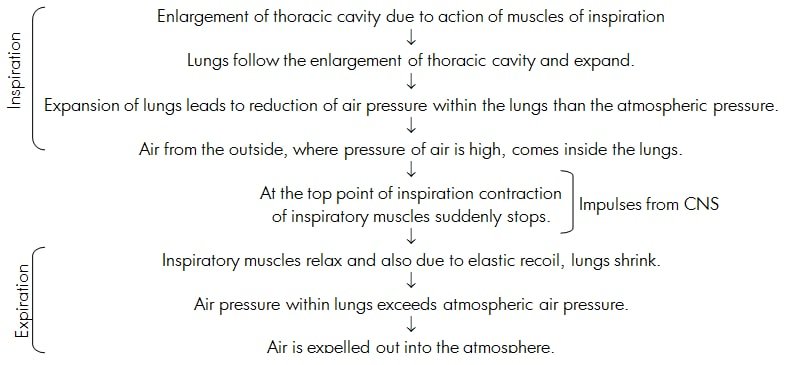
(ii) Exchange of gases:
(a) Exchange of gases in lungs: It is also called external respiration. In this gaseous exchange oxygen passes from alveoli to pulmonary capillary blood and CO2. Comes to alveoli from pulmonary capillary.
(2) Release of CO2 by the blood: The PCO2 (partial pressure of carbon dioxide) of blood reaching the alveolar capillaries is higher than the PCO2 of alveolar air. Therefore, carbon dioxide diffuses from the blood of alveolar capillaries into the alveolar air.
(b) Exchange of gases in tissues: In the tissues, exchange of gases occurs between the blood and the tissue cells. This exchange occurs via tissue fluid that bathes the tissue cells. The blood reaching the tissue capillaries has PO2 higher than that in the tissue cells and PCO2 lower than that in the tissue cells.
(iii) Transport of gases:
Blood carries O2 from respiratory organs to the tissue cells for oxidation and CO2 from tissue cells to respiratory organs for elimination. Blood should be slightly alkaline to help the transport of O2 and CO2 properly.
📖Difference between breathing and respiration
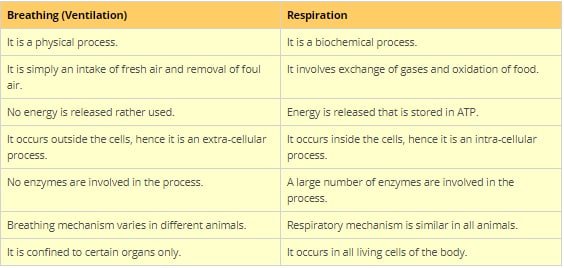
- Big Breaking 🔥 सुप्रीम कोर्ट का फैसला- DElEd जरुरी, 11 अगस्त 2023 के बाद नौकरी पाने वाले प्राथमिक शिक्षक हटाए जाएंगे
- मध्यप्रदेश उत्कृष्ट विद्यालय चयन परीक्षा 2024-25: आवेदन शुरू, यहां जाने प्रकिया एवं direct link
- कर्मचारी चयन मण्डल, भोपाल द्वारा वन विभाग एवं जेल विभाग की सीधी भर्ती परीक्षा-2022-23 शुद्धिपत्र जारी,जल्द होगा रिजल्ट जारी, पदों में वृद्धि
- Breaking News सीएम राइज़ विद्यालयों में प्रवेश: 2024-25 के लिए नोटिफिकेशन जारी यहां जानिए पूरी जानकारी एवं आवेदन की प्रक्रिया
- Kvs Class 1st Admission 2024 : केंद्रीय विद्यालय संगठन (केवीएस) कक्षा 1 प्रवेश 2024-25: जानिए आवश्यक दस्तावेज, पात्रता एवं ऑनलाइन आवेदन प्रक्रिया तथा डायरेक्ट लिंक Digital Education Portal








